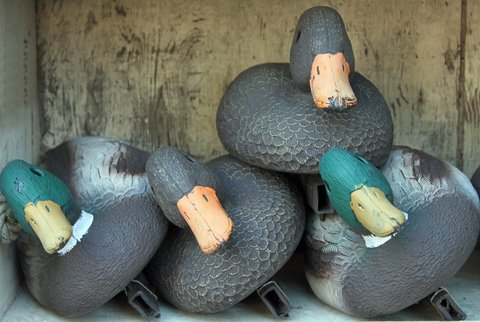Another duck season is in the books and you are already dreaming about next season as your mind replays the highlights from last fall’s outings.
Next season seems a long way off, but there are some productive ways to spend the off-season that will have you better prepared for your next duck hunting trip.
One way to use your down time is to haul out your decoys and make sure they are ready for next season. There is nothing worse than getting your decoys out on the water, only to realize that you have some significant problems, which could have been avoided.
Here are some necessary decoy maintenance tips, which will help you pass the time this winter and get you ready for next season.
Clean the birds
One of the most important decoy maintenance jobs is cleaning them. Carefully scrub each decoy with clean water and a brush, removing mud, weeds, dust and other grime that may have accumulated on your decoys over the course of the season.
Some soaps can alter the finish on your decoys, so it is best to avoid them. You want all your decoys looking their best when next season rolls around.
Damaged decoys
While you are cleaning your decoys, it is a great time to check each one for damage, such as cracks or pellet holes. If there is water in the decoy, it is likely you have some sort of damage.
To remove water, drill a pair of small holes in the decoy, to let it drain. Once it is drained, fill the holes with hot glue. Seal any cracks with epoxy or clear silicone. Once the glue or silicone is dry, test the decoys, to make sure they are no longer leaking.
If any of the decoys need touch-ups where they were scratched or chipped, this is the time to do it. Be sure to use a paint that is recommended for plastics and for outdoor use.
Check the lines
It may seem elementary to make sure all the lines are securely attached to the decoys, but many hunters fail to do this every year, and they have decoys that end up floating away.
Check the connections on each of your decoys. Re-tie knots or crimp the connections to make sure they are secure.
You should also check the lines for any damage. If you encounter any frayed, nicked or worn cords, this is the time to replace them.
While you are checking the cords, also check the weights, to make sure they are not loose and are in working order.
Storage
Make sure your decoys are securely covered for the season to avoid unnecessary dust build up or damage. Store them in a place that does not experience extremes in temperature. This will add to the life of your decoys by preventing them from becoming warped or brittle.
Also make sure they are stored in a dry place. If your decoy bag becomes wet, mildew and mold could appear, which will erase all your hard work cleaning the decoys.
Following these steps will keep your decoys in great shape and you will be ready to go when the new season arrives. Not to mention, it will give you something productive to do during the long off-season.
Photo credit: Dreamstime








